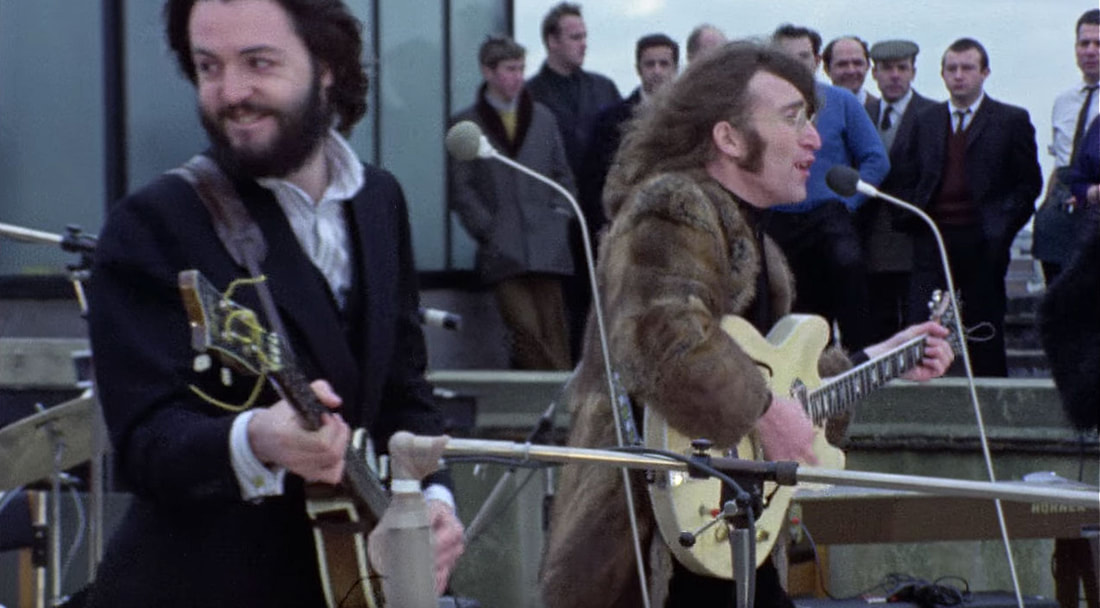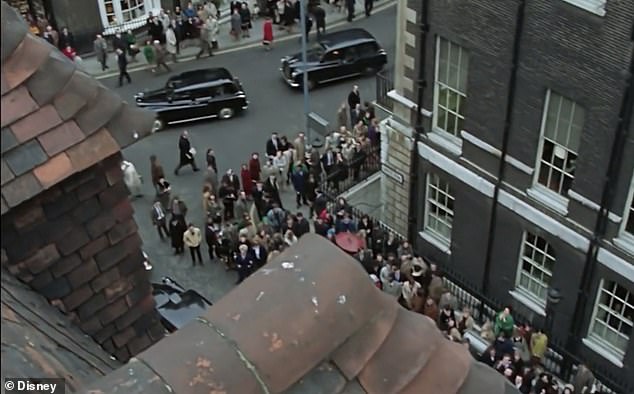|
Get Back — Peter Jackson’s extraordinary new reboot of Michael Lindsay-Hogg’s 1969 documentary footage following the Beatles’ penultimate recording sessions — has been revelatory in numerous ways, from its prompting of astute reconsideration of Yoko Ono’s much-maligned cultural narrative to final proof that Billy Preston utterly saved the day. The remarkable technology used to revive these old reels (and the audio) is important to attend to not only for its importance to the future of film restoration but for its increasing intrusion into filmmaking; Get Back is a highly computed film, perhaps the first movie many have seen with such dramatic and artistic contributions by an algorithm (“And the Oscar for Best Algorithm goes to…”?) — to the point that the documentary’s rotoscopic computation of imagery and sound can be seen as the construction of a kind of virtual reality. In addition to this surface virtuality of the image, however, I’m interested in the virtuality of the individuals shown through that imagery — and the ways Get Back is less a documentary about live human beings than it is about a socially constituted band of living ghosts. Get Back (and Lindsay-Hogg’s earlier compendium of the same footage, Let It Be) chronicles the Beatles at a critical juncture in their artistic career as pop-music leaders. After deciding to cease touring in 1966 largely because of the mayhem of Beatlemania, the quartet was afforded the opportunity to focus on making music to be listened to as records rather than reproduced on stages. This resulted in three subsequent albums of artful pop (Sgt. Pepper’s Lonely Hearts Club Band, Magical Mystery Tour, the “White Album”), each groundbreaking not only for the musicians creatively but for pop music broadly. Through their expansion of multitracking and sound manipulation, these records dialed up the technical potential of writing, performing, and recording music and cemented the cliché of “using the studio as an instrument.” All well and good, but the grass is always greener. Such technical developments demand a different work ethic, one in which the individual musicians conduct much of their work asynchronously; even after three years of pioneering chamber pop, the four lads reared on live, classic rock ‘n’ roll yearned once more for the crackle and spontaneity of synchronous playing. The Let It Be and Get Back documentaries both chronicle the rediscovery of the band’s magical, mysterious simultaneity and are propelled narratively by desires to re-present the band in this mode of performance — to get them back onto a stage (given its far wider hindsight, Jackson’s title is far more poignant) — but with parallel desires not to revive Beatlemania. In order to avoid the usual mayhem generated by public appearances, the band and their handlers try to plan a live event that maintains significant performative distance between the band and its audience. Across the eight hours of Get Back, that plan devolves from an outdoor concert in Libya to a TV special to the culmination of the film footage: the band’s final public performance atop the roof of their Savile Row offices. This in/famous end result is once again inevitably underwhelming from various points of view in Get Back, as the hastily chosen performance site and daytime scheduling present the proxy audience with a weird, uncanny experience — one that surfaces the virtuality of the band itself. Philip Auslander has written about this liminal status of the band. In “‘Nothing Is Real’: The Beatles as Virtual Performers” (from The Oxford Handbook of Music and Virtuality, in which I also have a chapter about the history of virtual pop performers), Auslander — a performance-studies scholar who long has argued for the inclusion of mediated recordings into his field’s insistence that performance is, by definition, unmediated — and co-author Ian Inglis claim that the Beatles in the late 1960s had “participated in musical scenarios that were, in fact, effective simulations of the conventional performer-audience encounter” (37). Defining a virtual performer (as most do throughout that handbook) as one available to audiences only through mediated representations, rather than their corporeal body, Auslander & Inglis chart the Beatles’ post-’66 virtualization through cartoons, promotional films, and the original Let It Be documentary. Describing the rooftop performance, Auslander & Inglis note that it “was not a concert — at least not in the usual sense — as it did not have, and was not intended for, a concert audience” (48). The drama of the documentaries’ final act, of course, is that the performance did have an audience: the people along the street who blocked traffic as they stopped to listen to the music. But, as Auslander & Inglis point out, these listeners were incidental — largely because all they could do is listen, since the band, on a roof five stories up, was unseen by nearly all spectators. Thus, as the films show, the music causes relatively mild curiosity. “Indeed, as shown in the film,” Auslander & Inglis write, “the people in the street below either paused to listen silently and respectfully, or simply moved on” (48). The intended audience for this live performance was one in another context and another time: “those who would experience the performance later on the movie screen, as performed by the virtual Beatles” (49). Watching Get Back (moreso, I think, than Let It Be) is akin to opening the black box of the Beatles’ technically constructed virtuality. The Beatles had not died (although what I’m describing here perhaps could stoke the rumors about Paul in newly amusing ways), but they had gone out of sight and into another realm, so to speak, reappearing only as mediated forms. If virtual performance is, by definition, mediated, and if most modern media is inherently haunted and haunting (per Sconce or Peters), then what Get Back affords us is a peek at the analog mechanisms that were then computing the Beatles’ historical and (to the public) ontological virtuality — a mostly unseen netherworld from which the concert promoters are trying to summon them and from which the musicians themselves are trying to re-emerge. Get Back documents a séance, of sorts. Instead of a spiritualist medium producing sound or imagery in a dark room meant to invoke the presence of the dead, the film produces the same result — more profoundly for us in the present day, given the death of two of the principal figures, but still an intentional conjuring of spectral figures via intrinsically haunting media. What fascinated me most, though, was the high degree to which the live performance itself seemed to be an uncanny, ghostly experience to the actual London passers-by. The rooftop concert was not announced in any way. Nonetheless, nearly every person on the street interviewed in Get Back names the source of the music as the Beatles; this is likely because they either recognized their sound (an intellectual act itself grounded in the Beatles’ previous foundations as live performers, as Auslander & Inglis note), recognized the address of the well-publicized new Apple Studios, or were tipped off by the presence of the film crews. Still, it’s almost a farce watching onlookers cast their eyes about, looking for the source of that music blaring from … somewhere, up there. The music sounds like a live performance, certainly less mediated than the band’s previous studio creations, so the actual Beatle bodies must also be up there, somewhere. But the only spectators who actually see the Beatles are a few on high floors and gathered on rooftops of other buildings, a small fraction of the available crowd — to which, again, this music is not really being performed. They simply are more literal bystanders, surrogates for the future film audience. Thus, what’s on display in this final act is the total spectrality of mediated experience. The band are ghosts, and so is the audience. The final performance of the Beatles was a séance that (as séances do) failed to fully materialize its subjects — in fact, it enhanced their virtuality. The spectacle of the event seems to suggest an ultimate manifestation of the band for the resulting audience, but one that never happens. Instead, a whole city block is haunted by the disembodied voices of a nation’s stubbornly liminal cultural heroes. You’re thinking of me, the same old way You were above me, but not today The only difference is you’re down there I’m looking through you And you’re nowhere
0 Comments
Leave a Reply. |
this blahg
I'm THOMAS CONNER, Ph.D. in Communication & STS, and a longtime culture journalist. Categories
All
Archives
June 2024
|



 RSS Feed
RSS Feed